Category: Hunting Blog
Getting Gobblers To Close The Distance
Shopping for turkey calls can be overwhelming. Stores have shelves packed with different turkey calls. Many calls swear to produce a unique sound. These various calls mimic the vocalizations that turkeys make. What they do not mimic are the other noises turkeys frequently produce.
Whether turkeys are flocked up or alone, they can be noisy in the woods. Scratching through leaves, flogging one another, and beating wings. While hunting, replicating these sounds adds another lifelike measure to your turkey hunting setups. These sounds are what turkeys are familiar with hearing.
During each turkey hunting setup, I put my back against a tree and lay my calls out around me. I grab a mouth call, then my friction call, and lastly my turkey wing! Yes, I carry a turkey wing in my vest. This “call” is placed on the ground within reach. When calling to a bird on the roost, I will use a wing to resemble the sound of a turkey flying down. I simply beat the wing against my leg a few times, pause, and then smack the leaves on the ground. This sequence communicates a turkey has flown off the roost, sailed, and then landed on the ground. Replicating this sound increases the realism of your setup.
Even after fly down I keep the wing handy. Turkeys do not stay still once they fly down. To resemble the sound of turkeys walking, I use the wing to scratch in the leaves. This allows me to stay in communication with a gobbler in between actual calling sequences. A longbeard expects to hear turkeys in the leaves as he approaches. If a gobbler begins to hang-up out of range, I don’t call. I scratch in the leaves. This is to reassure him that turkeys are here without making a turkey vocalization.
Lastly I carry a wing with me to create a fighting scenario. Turkeys establish pecking orders (watch GrowingDeer episode 328 here) in late winter. Pecking orders are challenged during the breeding season. These fights are generally loud and get turkeys to investigate. Fights among hens include aggressive fighting purrs and flogging. A last ditch effort is to create a fight. I purr aggressively on a mouth call and use a wing to replicate a fight. Simply purring aggressively may do the trick but beating wings takes this scene to the next level.
Don’t fall for some of the game call gimmicks. Save a wing, replicate what happens in nature on a daily basis. Using a wing can increase your odds of success in the spring woods. Remember wings are free with the harvest of any turkey! Draw that gobbler into range!
Chasing longbeards,
Matt
Breaking The Pecking Order
It is opening morning and the turkeys are still flocked up. Despite this, you get setup on a bird gobbling hard on the roost. You have high expectations until a few hens begin calling in the distance. The gobbler pitches off the roost right to them. He sounds off a time or two as the flock makes their way to an open field.
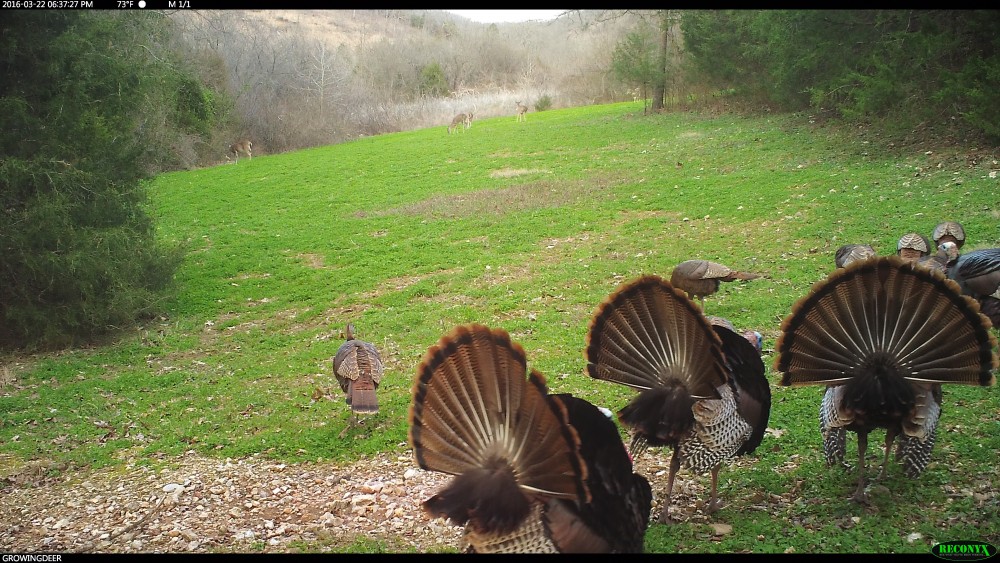
Perfect early season situation to fan or reap a gobbler.
What is your next move? Calling him away from the hens is out of the question. The field is flat as a pancake. You could pack it in and come back another day. But there is something special about punching a tag on opening day! Having a big arsenal during turkey season is critical to staying successful! Fanning or reaping may be the answer!
Throughout late winter, both gobblers and hens establish pecking orders. Turkeys have distinct social ranks throughout the flock. They sort out these roles by pecking, spurring, flogging, and chasing one another. This very behavior is what can turn the hunting scenario described above into a success – if you have the right gear.
Dominate gobblers do not take challenges well. They know where they rank! Any other gobbler who threatens them or their hens will be challenged. A fanning or strutting decoy, like the Fanatic from Montana Decoy, works wonders during these situations. This decoy is designed to hide the hunter as you stalk to a flock of turkeys across open terrain. Using a large strutting decoy suggests a challenge to the dominant bird. Usually resulting in a change of behavior! The longbeard may charge in looking for a fight.
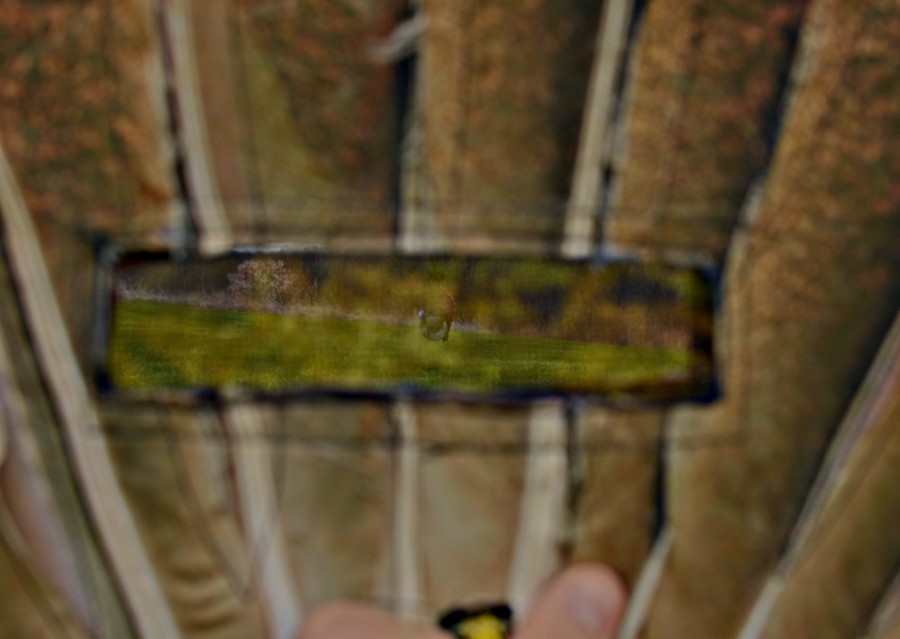
Stalking across open terrain IS possible! Just be ready for a charge.
Now that bird from opening morning is approachable. Even more important, he is harvestable! A note of caution! Before taking on this approach safety must be understood. Know your surroundings! Are there any other hunters in the area? You will need to know this before getting behind a strutting decoy. This technique is intense but works in the appropriate circumstances.
This spring don’t let a flock of hens or open terrain stop you from closing the distance on a longbeard. Check your surroundings and go after him! Be ready for some up close and personal action.
Chasing longbeards together,
Matt
Calling Gobblers Off The Roost
As season approaches for us here in the Midwest we are talking turkey tactics. We have already been out a few times listening for gobblers on the roost. These pre-season scouting trips give us an idea of where birds are roosting. This may change as season progresses, but until then, we start planning our tactics to intercept the birds. One thing that remains pretty consistent is how we communicate with birds while they are on the roost. Some folks say to never call to a gobbler while he is on the roost, while others call a lot! Where do you draw the line?
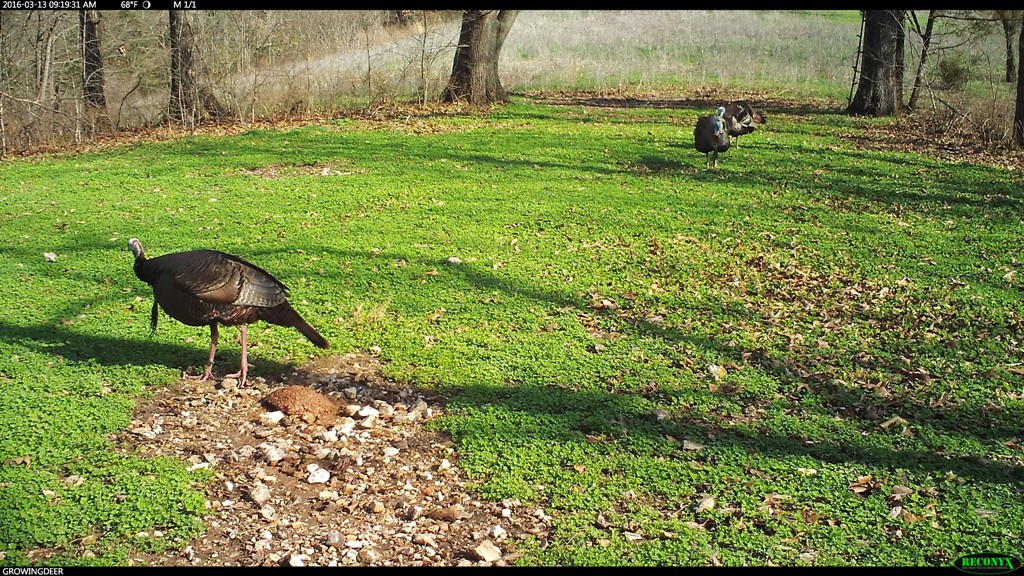
Try using these calling techniques to work gobblers into range.
Turkeys communicate with other birds on the roost 365 days a year. Turkeys use certain calls in specific sequences while on the roost. This sequence is exactly what we try to replicate when calling to a gobbler that is still on the roost. With our back against a tree and our Montana Decoys placed in front of us, the first turkey sound we make is a tree yelp! Tree yelps are soft notes intended to talk with other birds on limbs nearby. This call represents a “Hey! Good morning, I’m over here.” message. We may use this sequence a time or two before moving on to communicate another message! Next, we transition into a fly down cackle! As it gets lighter in the woods, you will here a more excited cutting sequence as birds fly off the limb. This call usually gets a good response from a gobbler. We may do this multiple times! As we call, we use a wing to make the sound of wings beating. This adds more realism to the setup. The gobbler now knows that multiple hens have hit the ground. Since turkeys are on the ground, the next process is to gather the flock. Assembly yelps are used to complete this message. This call is louder than the tree yelp. 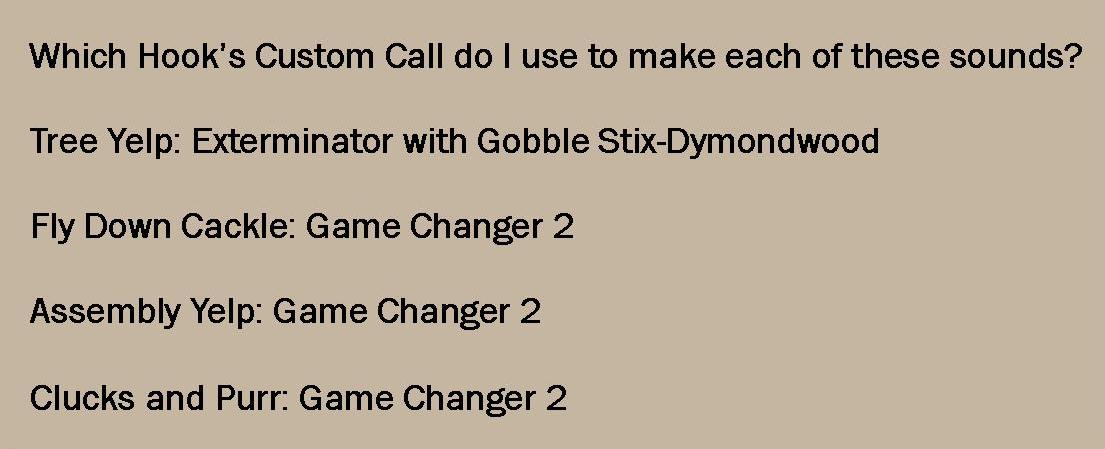 It broadcasts where the flock is to gather at. We follow up the gathering of the flock calls with soft clucks and purrs. These calls are calls of contentment. Clucks and purrs communicate safety as birds gather at your location. During this process we rake the leaves. This sounds like birds are feeding. Any sound, other than calling, that is natural in the turkey woods, we use! This makes our setup more realistic and enticing as he makes his final approach!
It broadcasts where the flock is to gather at. We follow up the gathering of the flock calls with soft clucks and purrs. These calls are calls of contentment. Clucks and purrs communicate safety as birds gather at your location. During this process we rake the leaves. This sounds like birds are feeding. Any sound, other than calling, that is natural in the turkey woods, we use! This makes our setup more realistic and enticing as he makes his final approach!
From the first call of the morning to when the Winchester sounds off, all calls communicate simple realistic messages to a gobbler. This natural calling technique leads many gobblers on their final approach each spring! May you be blessed with a productive spring listening not only to gobblers, but to the Creator as well!
Chasing longbeards together,
Matt
So…What’s The Deal With Cover Crops?
Over the past few years we have been testing different cover crop varieties and planting methods here at The Proving Grounds. We do this to continue learning how we can improve the soil. Food plots are fun to hunt over, but food plots are tools. These tools work to transfer nutrients from the soil to wildlife. Plants take nutrients from the soil and air then produce vegetation that is consumed by wildlife.
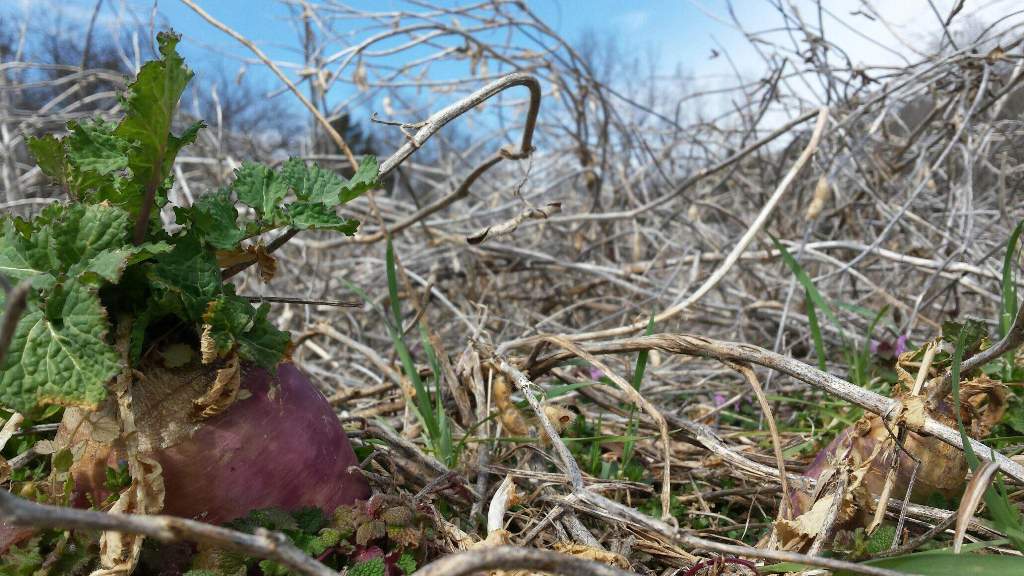
Eagle Seed Broadside mix drilled into standing beans makes for an excellent cover crop and forage for the local deer herd.
Some excellent research (watch episode #296 here) has been published confirming that better soil and nutrition means bigger and healthier deer. So, as you may have guessed by now, cover crops are used to improve your soil! There are many ways that cover crops or, in our plots, Eagle Seed Broadside, improve the soil’s health. Some of the benefits are immediate while others occur over time. Nevertheless, these improvements help to increase the quantity and quality of the nutrients that are available to the plants (watch episode #288 here).
Benefits of Cover Crops
- Cover crops keep the soil covered – Covering the soil shades out and limits weed growth in food plots. This decreases the amount of herbicide needed to control weeds.
- Cover crops reduce soil erosion – Rain droplets do not drop directly onto bare soil, therefore nutrients aren’t washed away.
- Cover crops keep nutrients in the top layer of the soil – Having an active root system year round keeps nutrients in reach of the roots rather than sinking lower into the soil.
- Cover crops decompose – Once vegetation from the cover crop is terminated, it begins to decompose. This acts as a slow release fertilizer which benefits the crops to follow.
- Cover crops are a source of mulch – The decomposing cover crops act as a mulch. Mulch holds in the necessary moisture for the soil and root system.
- Cover crops build organic matter – After the mulch breaks down it becomes organic matter which improves soil structure and overall fertility.
Do you keep your food plot’s soil active all year round? If not, I encourage you to plant cover crops. It will increase your soil’s fertility and allow you to grow larger and healthier deer!
GrowingDeer together,
Matt
Humidity: Great For Shed Hunting, Tough On Bow Hunters
Like many of you, I’ve been spending as much time as possible looking for shed antlers during the last several weeks. The Reconyx cameras were getting photos of a few bucks that were shedding early and that was all the encouragement I needed to get out and start shed hunting.
Shed hunting can often feel like hunting for a needle in the haystack. Folks that shed hunt in areas with large agriculture fields probably don’t understand that statement. “Flat landers” have a distinct advantage to those of us hunting in habitat that is primarily timber and mountainous. It’s something I dream of – taking my dog and hunting on flat land where the wind direction remains constant and the line of sight extends for more than 30 to 50 yards! My dog, Crystal, helps me overcome this limitation by using her nose to find shed antlers.The first couple of weeks shed hunting yielded few results. I found a few smaller antlers from yearling bucks without assistance from Crystal. After years of shed hunting with the dog that I had trained, it appeared she had lost her ability to find shed antlers. That all turned around this week.
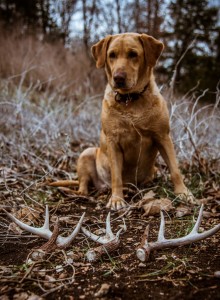
Crystal, a shed dog, found three antlers that were not in my line of sight.
On Monday afternoon Crystal and I walked and hunted for about 1 ½ hours. In that time she found three antlers that were not in my line of sight. On Wednesday she found two more small antlers. What brought about this change in Crystal? The weather. Over the weekend our farm received some much needed rain. Our area had been experiencing warmer and dryer temperatures than normal. Daytime humidity levels were very low. It made for great fire weather (watch this video) but poor conditions for a dog to scent an antler. When the air is humid it carries scent.
Not everyone reading this blog has a shed dog (a dog trained to find shed antlers) but there is a takeaway here for all deer hunters. It’s the power of an animal’s nose. Hunters in dry climates like western Kansas can bow hunt whitetails much “easier” than a hunter in a humid location like Florida. This is why Grant and the team are so picky about reducing their scent and the scent on their gear. This is also why they are very concerned about how they approach stands. The GrowingDeer Team’s scent control is much more than using a field spray, it’s based on hygiene and cleaning their gear in addition to using a field spray. If you want to understand more about the role of humidity in effective deer hunting, read the article Grant wrote here.
I have renewed confidence in my dog’s ability to hunt antlers. We’ll be out as often as possible. We will hunt smart and use our time wisely. We’ll concentrate on food plots, bedding areas, water sources, and move between those by following active trails and sign. To give Crystal the advantage we’ll hunt the wind direction and try to be out when the humidity levels are higher. We’ll keep you posted on our results on Facebook, Twitter, Instagram and Google Plus. If you’re not already connected with us – please join us today!
Trying to control my shed hunting addiction,
Tracy
Take Shed Hunting To The Next Level
It is that time of the year when thousands of people (including myself!) take to the woods in search of shed antlers. This is an attempt to get our hands on what remains of the missed opportunities we experienced this fall! Shed hunting is a great activity to get rid of cabin fever, stretch your legs, or introduce a child to the outdoors.
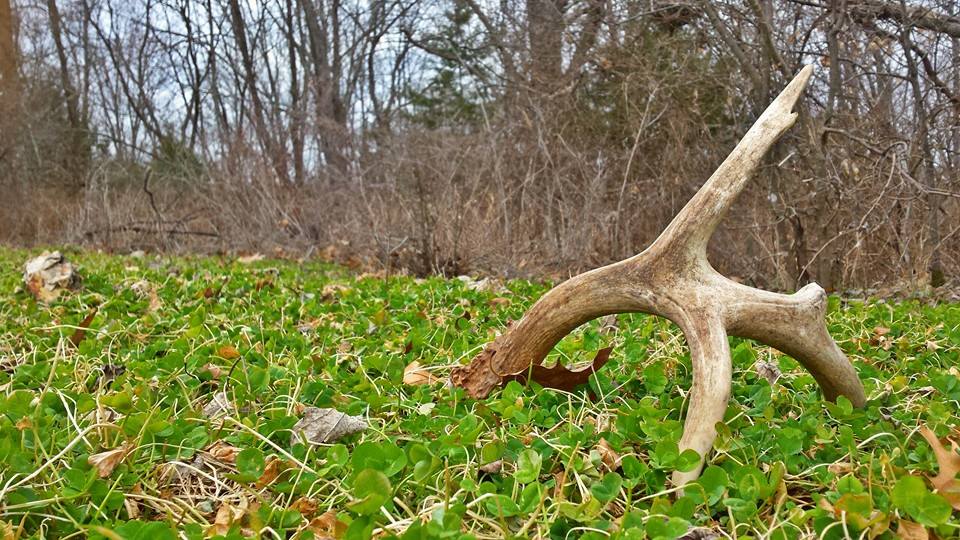
This shed is from Gumby, a hit list buck. The shed was found in a small clover plot that had a lot of activity this fall and winter.
As this activity has increased with popularity over the past few years, tips and advice have flooded the outdoor magazines and web. These tips have most likely increased the productivity of finding sheds each year. But what happens when the conditions during the winter have been anything but normal? Should you change your shed hunting tactics?
Today, the forecast is calling for temperatures to reach 70 degrees! This is not our typical mid-February weather. This type of weather has come and gone for us most of the winter. Since this trend has continued we will have to alter our shed hunting tactics. The typical advice to concentrate your shed hunting efforts on south facing slopes may not be the best approach. Or perhaps you focus on the areas where deer typically feed during the late winter. These locations typically result in a good chance to find those cast antlers. However, this approach should be altered if you have seen unseasonably warm temperatures this winter.
To remain successful while shed hunting, we are constantly analyzing our Reconyx cameras and the sign we see while in the field. As a result, this shed season, we are concentrating our efforts on north facing slopes and around our Eagle Seed Broadside and clover plots. Deer have been feeding heavily in these plots since they have remained green and growing even this late into winter. Our Reconyx cameras have allowed us to identify where bucks are located, what they are feeding on, as well as the direction they are traveling from. This allows us to make a plan based on the current bedding and feeding patterns, opposed to generalized shed hunting tips. This information maximizes our chances of success, instead of aimlessly walking through the woods in areas where sheds this winter are unlikely to be found.
GrowingDeer together,
Matt Dye
Why Do We Burn Before Growing Season?
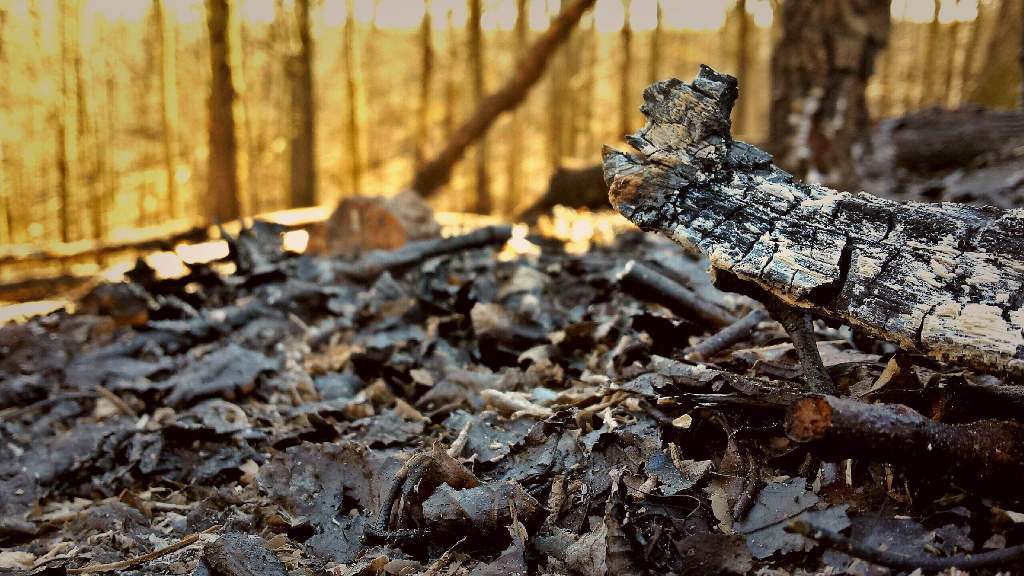
The results of our recent burn show promising signs for spring green up in this block of timber.
Do you hunt timbered ground? The Proving Grounds is dominated by timber. That means we have a lot of timbered ground that we have to manage. As often as we can, we choose to manage our land in the most natural way possible. This helps to keep our land progressing in its intended fashion.
One of the best ways we chose to manage our timbered acres is by burning each year before the start of the growing season. This accomplishes many goals for both of our habitat and deer management plans. The intention during each of these burns is to remove all the duff or leaf litter on the forest floor. These leaves or fuel have built up over a few years since the previous burn was completed. During this time of the year on days when the humidity levels are low, we begin our prescribed fire!
Each burn unit has set fire lines that have been blown days in advance. This allows us to act fast when the weather conditions turn favorable to burn. These prescribed fires we conduct within the timber are slow backing fires. We do not set a head fire in our timbered areas. Our goal is to remove all the leaves, exposing the soil. We do not want to damage our large hardwood trees. When we remove the leaves from within the timber, the soil is then exposed. When the growing season begins, sunlight and the warming soil temperatures allows for germination and new growth to spring up. These burned areas are quickly converted from simple leaf duff to a “timbered food plot”. Deer are natural browsers, so with the diversity of vegetation that begins to grow, this area becomes highly attractive to them. Turkeys also frequent these areas as they will consume earthworms and grubs that are exposed by removing the leaves. They will make a return when the new vegetation begins to sprout out of the ground.
Burning is not just a management tool that benefits your timber; it also creates additional forage for wildlife. We are looking forward to spring green up so we can provide you with updates on the progression of our prescribed burns.
GrowingDeer together,
Matt Dye
Warning: This blog contains information about prescribed fire which is a management tool for trained professionals using the appropriate tools for the situation.
Managing Feral Hog Populations
This week Adam and I are in Western Oklahoma. We have a client whose property has recently experienced a lot of hog damage. Feral hogs are not native to this continent. They arrived years ago as early explorers discovered the Americas. These non-native invasive species are tough to manage as they repopulate quickly. This is because feral hog sows can produce 2 to 3 litters each year! Each litter size can range from 10 to 15 piglets. This means one sow can rear 30 to 45 piglets in a given year.
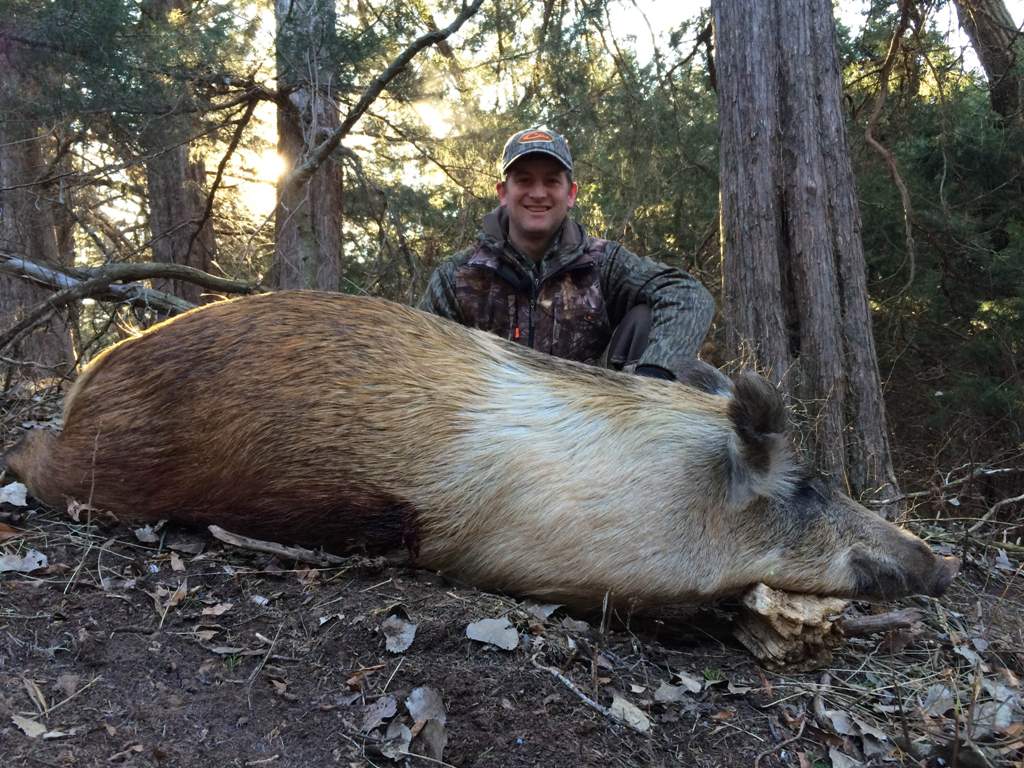
Adam recently tagged this large sow during a hunt in Western Oklahoma.
How do you manage such an active population? Trapping feral hogs has proven to be the most effective way to manage these populations. Trapping allows a landowner to potentially remove a large amount of hogs at one time. Entire sounders have been trapped and removed with trapping efforts. If trapping is not an option, intense hunting pressure is the next most effective way to keep hogs from doing damage to a property. Feral hogs react to intense hunting pressure. They will often leave an area that they feel is unsafe.
Baiting an area, where legal, will condition hogs to this specific location. When hogs become use to the bait site and start using it during daylight hours, then it is time to hunt! Put in time and hunt these areas. Not only will you be harvesting and removing feral hogs, but sending a message to them as well. The message is that this area is now unsafe! Hopefully this will result in hogs moving off your property.
Growing Deer together,
Matt
Understanding Brain Abscesses
A recent harvest of a buck we call Gappy yielded some interesting post harvest findings. Gappy was seen on our Reconyx cameras early during November with a blind eye and wounds to his head. It appeared he had been in a recent tussle. Over a month later, on December 18, I was fortunate enough to harvest him. During the recovery process we inspected the blind eye but also noticed infection around the base of his left antler. We were interested to see what the skull looked like once we got the European mount back.
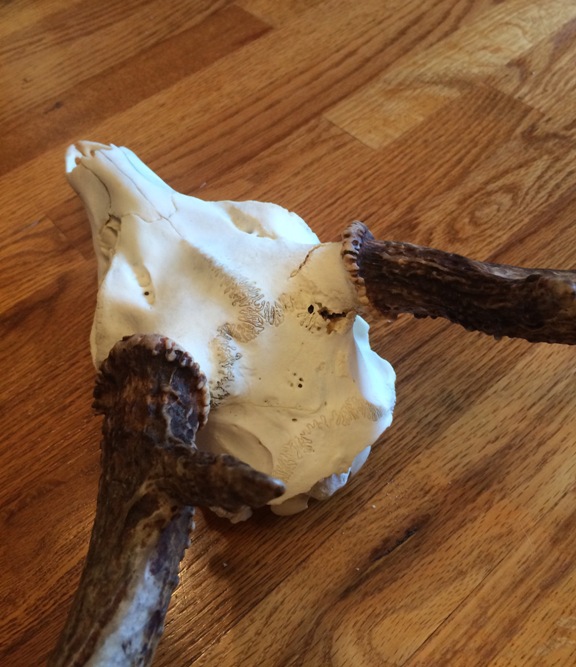
Gappy’s skull post harvest. This hole was caused by a brain abscess; note the pitting around the hole.
At first glance we noticed a large hole in the skull and a hairline fracture around the left pedicle. The hole is deep enough to see a small amount of light coming into the brain cavity. These signs pointed to a severe condition known as a brain abscess. If I had not been fortunate enough to have harvested Gappy, the road did not look promising for him. Discovering his condition encouraged me to further research brain abscesses.
Most abscesses start out as a cranial abscess or simply an infection of the head. A specific bacteria (Trueperella pyogenes) forms in these injuries. Once present the bacteria begin to erode the skull. In the case of Gappy, the eroding away of the skull caused a large hole to form (see photo). The bacteria had progressed enough to reach the brain cavity. Once this occurs this condition is known as a brain abscess. This condition is usually fatal once the bacteria reaches the brain cavity. In some cases a deer can fight the infection off and survive a cranial abscess. If so, there are usually signs of pitting where the bacteria began to erode the skull plates.
Cranial abscesses have the ability to cause serious injury and even lead to death. As you hit the woods in search of shed antlers this winter be sure to look for any signs of a brain abscess. A buck with a brain abscess can shed portions of their skull when antlers are cast. If you don’t shed hunt, but have European mounts from past harvests, examine those for potential cranial or brain abscesses. There is always much to learn even after the harvest is over!
End Of Season Inventory
Bow season has now been closed here in Missouri for a week. Adam was able to harvest a doe on the last evening, ending the season on a high note. Although it’s only been one week without deer season the preparations for next year have already begun.
Our Reconyx cameras stay out all year long. We are now in the process of taking an inventory of what bucks survived the hunting season and in what condition they are entering winter stress period. This information is valuable for multiple reasons. First and foremost we want to be able to monitor their movements and identify their core areas. This is especially true for the 3.5 year old bucks who will make the hit list for the upcoming season. We didn’t spend our time this fall trying to understand those deer and their patterns of movement. However, now as we prepare for next season we will we use this information to go back and look at trends in movement from those individual bucks that were recorded this past fall. This prepares us for the following seasons as deer are creatures of habit. A buck may move under similar conditions within the same areas from year after year. If we have this information already recorded and analyzed then we can confidently go into our Summit stands the following season.
In addition to keeping our cameras running all year long, we also keep our Trophy Rock Four65 locations supplied throughout the year. Deer need a supply of mineral year round especially during the winter stress period. Setting our Reconyx cameras on these locations allows us to gather the information we are looking for at this time of the year.
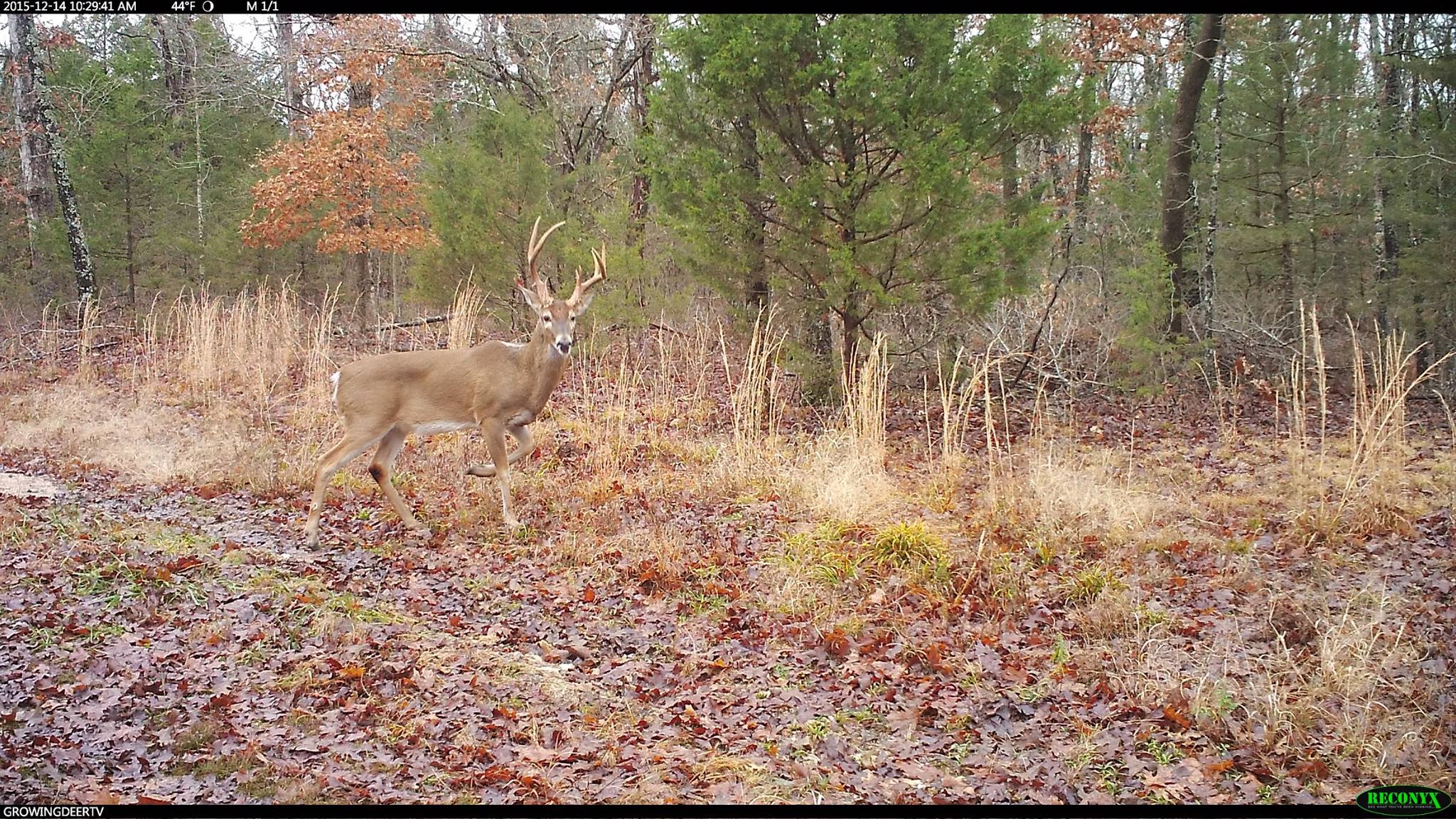
We are watching and learning this buck’s movements.
Although we cannot chase whitetails during the next few months we are going to actively prepare ourselves for the next opportunity. Make sure you keep your cameras running through the winter. The information gathered from the pictures will allow you to learn more about each individual deer. That information serves a greater purpose in the coming months!
Growing Deer together,
Matt Dye



